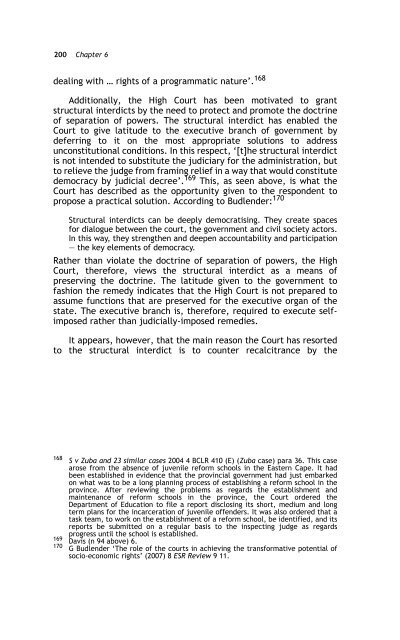LITIGATING SOCIO-ECONOMIC RIGHTS IN SOUTH AFRICA - PULP
LITIGATING SOCIO-ECONOMIC RIGHTS IN SOUTH AFRICA - PULP
LITIGATING SOCIO-ECONOMIC RIGHTS IN SOUTH AFRICA - PULP
Create successful ePaper yourself
Turn your PDF publications into a flip-book with our unique Google optimized e-Paper software.
200 Chapter 6<br />
dealing with … rights of a programmatic nature’. 168<br />
Additionally, the High Court has been motivated to grant<br />
structural interdicts by the need to protect and promote the doctrine<br />
of separation of powers. The structural interdict has enabled the<br />
Court to give latitude to the executive branch of government by<br />
deferring to it on the most appropriate solutions to address<br />
unconstitutional conditions. In this respect, ‘[t]he structural interdict<br />
is not intended to substitute the judiciary for the administration, but<br />
to relieve the judge from framing relief in a way that would constitute<br />
democracy by judicial decree’. 169 This, as seen above, is what the<br />
Court has described as the opportunity given to the respondent to<br />
propose a practical solution. According to Budlender: 170<br />
Structural interdicts can be deeply democratising. They create spaces<br />
for dialogue between the court, the government and civil society actors.<br />
In this way, they strengthen and deepen accountability and participation<br />
— the key elements of democracy.<br />
Rather than violate the doctrine of separation of powers, the High<br />
Court, therefore, views the structural interdict as a means of<br />
preserving the doctrine. The latitude given to the government to<br />
fashion the remedy indicates that the High Court is not prepared to<br />
assume functions that are preserved for the executive organ of the<br />
state. The executive branch is, therefore, required to execute selfimposed<br />
rather than judicially-imposed remedies.<br />
It appears, however, that the main reason the Court has resorted<br />
to the structural interdict is to counter recalcitrance by the<br />
168<br />
S v Zuba and 23 similar cases 2004 4 BCLR 410 (E) (Zuba case) para 36. This case<br />
arose from the absence of juvenile reform schools in the Eastern Cape. It had<br />
been established in evidence that the provincial government had just embarked<br />
on what was to be a long planning process of establishing a reform school in the<br />
province. After reviewing the problems as regards the establishment and<br />
maintenance of reform schools in the province, the Court ordered the<br />
Department of Education to file a report disclosing its short, medium and long<br />
term plans for the incarceration of juvenile offenders. It was also ordered that a<br />
task team, to work on the establishment of a reform school, be identified, and its<br />
reports be submitted on a regular basis to the inspecting judge as regards<br />
progress until the school is established.<br />
169 Davis (n 94 above) 6.<br />
170<br />
G Budlender ‘The role of the courts in achieving the transformative potential of<br />
socio-economic rights’ (2007) 8 ESR Review 9 11.
















